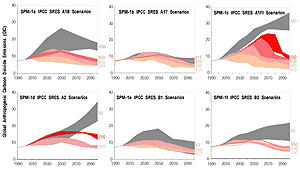Introduction
1. This report assesses the scientific, technological,
environmental, economic and social aspects of the mitigation of climate change.
Research in climate change mitigation 1
has continued since the publication of the IPCC Second Assessment Report (SAR),
taking into account political changes such as the agreement on the Kyoto Protocol
to the United Nations Framework Convention on Climate Change (UNFCCC) in 1997,
and is reported on here. The Report also draws on a number of IPCC Special Reports,
notably the Special Report on Aviation and the Global Atmosphere, the Special
Report on Methodological and Technological Issues in Technology Transfer (SRTT),
the Special Report on Emissions Scenarios (SRES), and the Special Report on
Land Use, Land Use Change and Forestry (SRLULUCF).
The Nature of the Mitigation Challenge
2. Climate change 2
is a problem with unique characteristics. It is global, long-term (up to
several centuries), and involves complex interactions between climatic, environmental,
economic, political, institutional, social and technological processes. This
may have significant international and intergenerational implications in the
context of broader societal goals such as equity and sustainable development.
Developing a response to climate change is characterized by decision-making
under uncertainty and risk, including the possibility of non-linear and/or irreversible
changes (Sections 1.2.5, 1.3,
10.1.2, 10.1.4, 10.4.5).
3
|

Figure SPM.1: Comparison of reference and stabilization scenarios.
The figure is divided into six parts, one for each of the reference scenario
groups from the Special Report on Emissions Scenarios (SRES, see
Box SPM.1). Each part of the figure shows the range of total global
CO2 emissions (gigatonnes of carbon (GtC)) from all anthropogenic
sources for the SRES reference scenario group (shaded in grey) and the
ranges for the various mitigation scenarios assessed in the TAR leading
to stabilization of CO2 concentrations at various levels (shaded
in colour). Scenarios are presented for the A1 family subdivided into
three groups (the balanced A1B group (Figure SPM.1a), non-fossil fuel
A1T (Figure SPM.1b) and the fossil intensive A1FI (Figure SPM.1c)) with
stabilization of CO2 concentrations at 450, 550, 650 and 750
ppmv; for the A2 group with stabilization at 550 and 750 ppmv in Figure
SPM.1d, the B1 group with stabilization at 450 and 550 ppmv in Figure
SPM.1e, and the B2 group with stabilization at 450, 550 and 650 ppmv in
Figure SPM.1f. The literature is not available to assess 1000 ppmv stabilization
scenarios. The figure illustrates that the lower the stabilization level
and the higher the baseline emissions, the wider the gap. The difference
between emissions in different scenario groups can be as large as the
gap between reference and stabilization scenarios within one scenario
group. The dotted lines depict the boundaries of the ranges where they
overlap.
|
3. Alternative development paths 4
can result in very different greenhouse gas emissions. The SRES and the
mitigation scenarios assessed in this report suggest that the type, magnitude,
timing and costs of mitigation depend on different national circumstances and
socio-economic, and technological development paths and the desired level of
greenhouse gas concentration stabilization in the atmosphere (see Figure
SPM.1 for an example for total CO2 emissions). Development paths
leading to low emissions depend on a wide range of policy choices and require
major policy changes in areas other than climate change (Sections 2.2.2,
2.3.2,
2.4.4,
2.5).
4. Climate change mitigation will both be affected by, and
have impacts on, broader socio-economic policies and trends, such as those relating
to development, sustainability and equity. Climate mitigation policies may
promote sustainable development when they are consistent with such broader societal
objectives. Some mitigation actions may yield extensive benefits in areas outside
of climate change: for example, they may reduce health problems; increase employment;
reduce negative environmental impacts (like air pollution); protect and enhance
forests, soils and watersheds; reduce those subsidies and taxes which enhance
greenhouse gas emissions; and induce technological change and diffusion, contributing
to wider goals of sustainable development. Similarly, development paths that
meet sustainable development objectives may result in lower levels of greenhouse
gas emissions (Sections 1.3,
1.4, 2.2.3,
2.4.4,
2.5, 7.2.2, 8.2.4).
5. Differences in the distribution of technological, natural
and financial resources among and within nations and regions, and between generations,
as well as differences in mitigation costs, are often key considerations in
the analysis of climate change mitigation options. Much of the debate about
the future differentiation of contributions of countries to mitigation and related
equity issues also considers these circumstances 5
. The challenge of addressing climate change raises an important issue of equity,
namely the extent to which the impacts of climate change or mitigation policies
create or exacerbate inequities both within and across nations and regions.
Greenhouse gas stabilization scenarios assessed in this report (except those
where stabilization occurs without new climate policies, e.g. B1) assume that
developed countries and countries with economies in transition limit and reduce
their greenhouse gas emissions first.6
6. Lower emissions scenarios require different patterns
of energy resource development. Figure SPM.2
compares the cumulative carbon emissions between 1990 and 2100 for various SRES
scenarios to carbon contained in global fossil fuel reserves and resources 7
. This figure shows that there are abundant fossil fuel resources that will
not limit carbon emissions during the 21st century. However, different
from the relatively large coal and unconventional oil and gas deposits, the
carbon in proven conventional oil and gas reserves, or in conventional oil resources,
is much less than the cumulative carbon emissions associated with stabilization
of carbon dioxide at levels of 450 ppmv or higher (the reference to a particular
concentration level does not imply an agreed-upon desirability of stabilization
at this level). These resource data may imply a change in the energy mix and
the introduction of new sources of energy during the 21st century.
The choice of energy mix and associated investment will determine whether, and
if so, at what level and cost, greenhouse concentrations can be stabilized.
Currently most such investment is directed towards discovering and developing
more conventional and unconventional fossil resources (Sections 2.5.1,
2.5.2,
3.8.3, 8.4).
